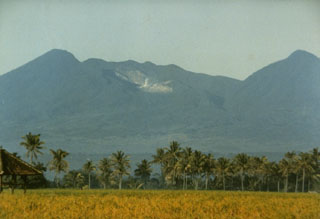Report on Papandayan (Indonesia) — 18 November-24 November 2015
Smithsonian Institution / US Geological Survey
Weekly Volcanic Activity Report, 18 November-24 November 2015
Managing Editor: Sally Sennert.
Please cite this report as:
Global Volcanism Program, 2015. Report on Papandayan (Indonesia) (Sennert, S, ed.). Weekly Volcanic Activity Report, 18 November-24 November 2015. Smithsonian Institution and US Geological Survey.
Papandayan
Indonesia
7.3175°S, 107.7306°E; summit elev. 2643 m
All times are local (unless otherwise noted)
PVMBG reported that during 1 September-16 November seismicity at Papandayan was dominated by shallow volcanic earthquakes but also consisted of deep volcanic earthquakes, low-frequency earthquakes, harmonic tremor, and hybrid events. Visual monitoring occurred from the Pakuwon Village post where observers noted white plumes rising at most 35 m above the crater. The Alert Level remained at 2 (on a scale of 1-4); residents and tourists were reminded not to approach the craters within a 1-km radius.
Geological Summary. Papandayan is a complex stratovolcano at the S end of a curved volcanic massif with Kendang volcano ~9 km away at the N end, Gunung Puntang ~3.5 km NNE, and Gunung Jaya ~6 km NNE. Several episodes of collapse have created an irregular profile and produced debris avalanches that have affected lowland areas. The summit area includes four large craters, including the 1.1-km-wide, flat-floored Alun-Alun crater. A sulfur-encrusted fumarole field occupies the active Kawah Mas ("Golden Crater"). The first reported eruption, in 1772 CE, included a collapse of the NE flank and a debris avalanche that destroyed 40 villages and killed almost 3,000 people. Smaller phreatic eruptions occurred during 1923-25, 1942, and 2002.
Source: Pusat Vulkanologi dan Mitigasi Bencana Geologi (PVMBG, also known as CVGHM)

